Calculation Method of Stable Bearing Capacity of Fastener-Type Steel Pipe Formwork Support Upright Rod
Abstract
1. Introduction
2. Material and Methods
2.1. Torsional Stiffness Performance Test of Right Angle Fastener
2.1.1. Test Program
2.1.2. Testing Apparatus
2.1.3. Test Loading Method
2.1.4. Test Data Results
2.2. Semirigid Connection Frame Theory with Lateral Displacement
2.2.1. Theoretical Calculated Length Factor for Frames with Laterally Shifted Semirigid Connections
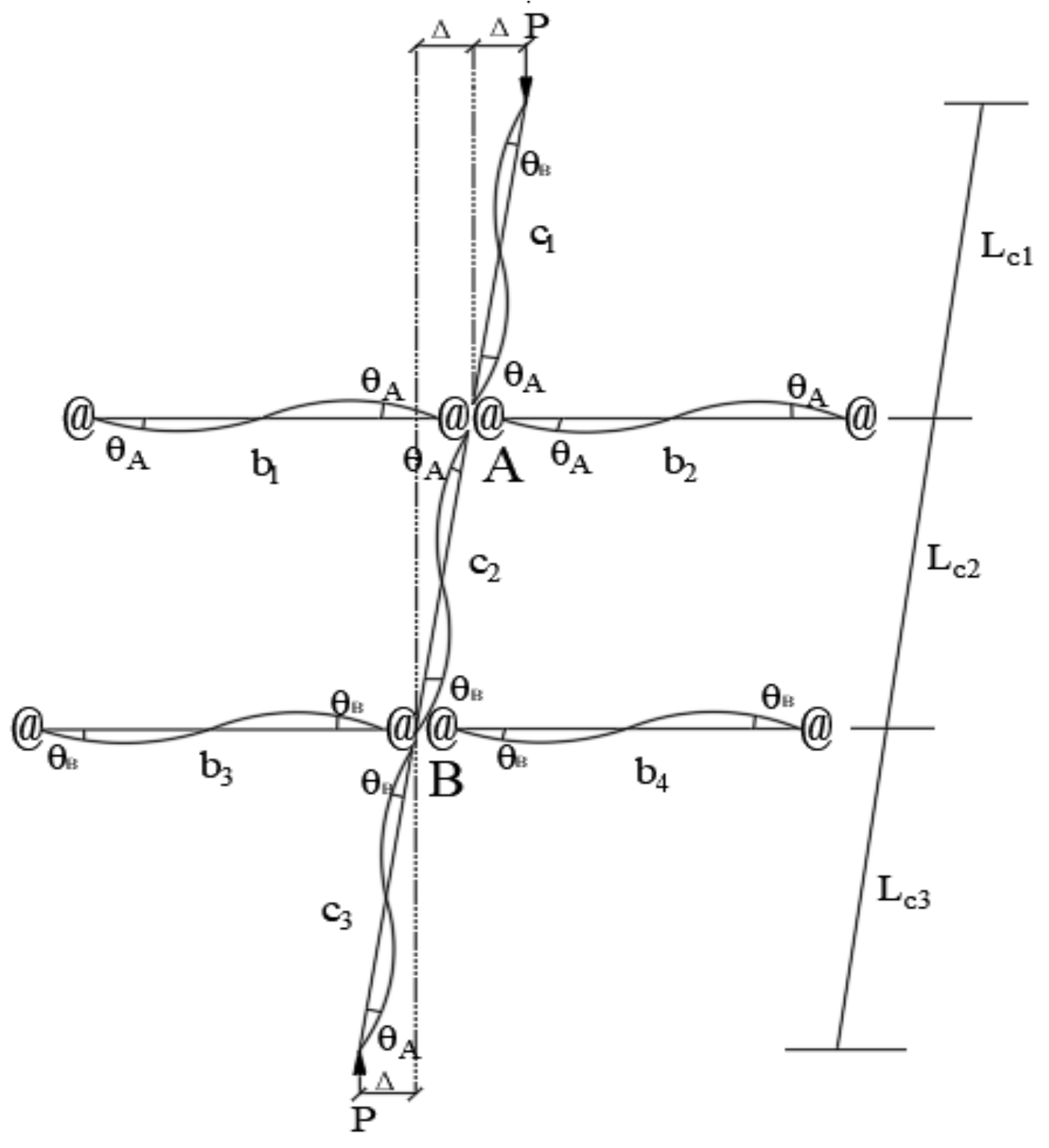
- —Upper end constraint coefficient of frame column with lateral displacement considering semirigid joints
- —Constraint coefficient of lower end of frame column with lateral displacement considering semirigid joints
- —Bending stiffness of beam section
- —Beam length
- —Bending stiffness of column section
- —Column length
- —Stiffness correction coefficient of frame beam with lateral displacement
2.2.2. Consider the Node Semirigid Crossbar Stiffness Coefficient Correction
2.2.3. Calculation of Stable Bearing Capacity of Vertical Bar Based on Theory of Semirigid Connection Frame with Lateral Displacement
- —Bending stiffness of steel tube
- —Rotational stiffness of right angle fastener
- —Lag spacing
- —Extension
- —Lag spacing
2.3. Calculation of the Stable Bearing Capacity of the Current Specification Uprights
2.3.1. Stability Calculation Formula of Pole
- N—Calculate the design value of the axial force of the vertical rod section;
- φ—The stability coefficient of the axially compressed rod, according to the length-to-slend ratio λ, is taken from the specification;
- A—Cross-sectional area of uprights;
- MW—Calculate the bending moment of the vertical pole section generated by the design value of wind load;
- f—Design value of compressive strength of steel, f = 205 N/mm2.
- k—Calculation of length addition factor;
- h—Pace;
- a—The length of the vertical rod extending from the center line of the top-level horizontal rod to the support point;
- μ1, μ2—Calculated length coefficient of a single pole considering the overall stability of the frame.
2.3.2. Calculation Formula for Pole Stability
2.4. Finite Element Analysis Modeling
2.4.1. Material Parameters and Section Geometry Properties
2.4.2. Basic Assumptions of the Computational Model
- (1)
- The connection between the frame and the ground is considered as articulated and the uneven settlement of the foundation is not considered.
- (2)
- The effects of wind and earthquake loads on the frame body are not considered.
- (3)
- Ignore the effect of axial deviation between the frame bars, assuming that all bars in the frame are axially in the same frame plane.
- (4)
- The connection of scissor braces to other bars is considered as hinged.
- (5)
- The vertical load is uniformly applied to the top of each rod, and the load is not eccentric.
2.4.3. Finite Element Model
2.4.4. Analysis of the Stable Bearing Capacity of the Uprights
3. Result
4. Discussion
5. Conclusions
- (1)
- Through the experimental study on the torsional stiffness performance of right-angle fasteners, the moment–rotation relationship model of joints and the corresponding initial stiffness of joints under different working conditions are obtained.
- (2)
- The influence of step distance and vertical bar spacing on the stability bearing capacity of the frame is consistent, which is reflected by the theory, specification, and finite element results of the stability bearing capacity of the vertical bar.
- (3)
- Based on the theory of semirigid frame with lateral displacement, the stability bearing capacity of the vertical bar is compared with the calculation results according to the current code. It is found that the maximum error is 24.7% and the minimum error is 1.5%. The finite element analysis results of the stability bearing capacity of the vertical bar are the largest, because the finite element analysis model is ideal.
Author Contributions
Funding
Institutional Review Board Statement
Informed Consent Statement
Data Availability Statement
Acknowledgments
Conflicts of Interest
References
- Guo, Z. The development and prospect of formwork scaffold technology. Constr. Technol. 2018, 6, 79–83. [Google Scholar]
- Shao, Z. Study on Stability Bearing Capacity and Progressive Collapse Prevention of Inclined Pillar Formwork Support of Cooling Tower. Master’s Thesis, Shandong University, Jinan, China, 2018. Available online: https://kns.cnki.net/KCMS/detail/detail.aspx?dbname=CMFD201802&filename=1018099375.nh (accessed on 12 February 2023).
- Hu, C.; Guo, Y.; Mei, Y.; Bao, X. Experimental study on bearing capacity of formwork support system. J. Xi’an Univ. Archit. Technol. 2017, 2, 179–186. [Google Scholar] [CrossRef]
- Hu, C.; Che, J.; Zhang, H.; Dong, P. Analysis of the influence of semi-rigid joints on the stability bearing capacity of fastener-style steel tubular formwork supports. Ind. Build. 2010, 2, 20–23. [Google Scholar] [CrossRef]
- Zhuang, J.; Cai, X. Study on anti-sliding constitutive relation of steel tubular joints with right-angle fasteners. Constr. Technol. 2011, 5, 79–81. [Google Scholar]
- Lu, Z.; Guo, C.; Yang, Y.; Chen, Z. Effect of fastener eccentricity on bearing capacity of steel pipe formwork support. Industrial Building 2016, 1, 140–146. [Google Scholar] [CrossRef]
- Lu, Z.; Guo, C.; Li, Y.; Chen, Z.; Zhao, L.; Yu, L. Experimental study on bearing capacity of ultra-high fastener type steel pipe scaffold. Constr. Technol. 2016, 15, 82–85+118. [Google Scholar]
- Lu, Z.; Guo, C.; Wen, Y.; Chen, Z.; Liu, T.; Cao, S. Study on the bearing capacity of fastener-style steel tube full support system under eccentric load. J. Dalian Univ. Technol. 2016, 1, 20–27. [Google Scholar]
- Li, S.; Wang, J.; Yu, Z.; Li, Y.; Guo, H. Study on the Bearing Capacity of Steel Formwork Concrete Columns. Buildings 2023, 13, 820. [Google Scholar] [CrossRef]
- Zhao, L.; Zhang, H.; Mbachu, J. Multi-Sensor Data Fusion for 3D Reconstruction of Complex Structures: A Case Study on a Real High Formwork Project. Remote Sens. 2023, 15, 1264. [Google Scholar] [CrossRef]
- Makarova, A.A.; Kaliberda, I.V.; Kovalev, D.A.; Pershin, I.M. Modeling a Production Well Flow Control System Using the Example of the Verkhneberezovskaya Area. In Proceedings of the 2022 Conference of Russian Young Researchers in Electrical and Electronic Engineering (ElConRus), Saint Petersburg, Russia, 25–28 January 2022; pp. 760–764. [Google Scholar] [CrossRef]
- Makarova, A.A.; Mantorova, I.V.; Kovalev, D.A.; Kutovoy, I.N. The Modeling of Mineral Water Fields Data Structure. In Proceedings of the 2021 IEEE Conference of Russian Young Researchers in Electrical and Electronic Engineering (ElConRus), St. Petersburg and Moscow, Russia, 26–29 January 2021; pp. 517–521. [Google Scholar] [CrossRef]
- Martirosyan, A.V.; Ilyushin, Y.V. Modeling of the Natural Objects’ Temperature Field Distribution Using a Supercomputer. Informatics 2022, 9, 62. [Google Scholar] [CrossRef]
- Jia, L. Study on Mechanical Properties and Design Method of Steel Tubular Scaffold with Fasteners. Ph.D. Thesis, Tianjin University, Tianjin, China, 2017. Available online: https://kns.cnki.net/KCMS/detail/detail.aspx?dbname=CDFDLAST2020&filename=1019894533.nh (accessed on 2 January 2023).
- Jia, L.; Liu, H.; Chen, Z.; Liu, Q.; Wen, S. Checking method for bearing capacity of fastener-style steel tubular scaffold. Build. Struct. 2016, 6, 71–76. [Google Scholar] [CrossRef]
- Cheng, H. Destructive experimental study on neutral rod of fastener-type steel pipe formwork support system. Master’s Thesis, Shenyang Jianzhu University, Shenyang, China, 2014. Available online: https://kns.cnki.net/KCMS/detail/detail.aspx?dbname=CMFD201701&filename=1015360493.nh (accessed on 6 April 2023).
- Xie, X.; Chen, G.; Yin, L. Multi-parameter simulation method for semi-rigid joints of steel tubular fastener scaffold. Chin. J. Civ. Environ. Eng. 2019, 4, 92–103. [Google Scholar]
- Lin, H.; Huang, C.; Liu, C.; Li, Y.; Liu, J.; Lu, L.; Xie, M. Scaffolding experimental study and finite element analysis considering right-angle fastener failure. Build. Struct. 2019, S2, 689–695. [Google Scholar] [CrossRef]
- Saritas, A.; Koseoglu, A. Distributed inelasticity planar frame element with localized semi-rigid connections for nonlinear analysis of steel structures. Int. J. Mech. Sci. 2015, 96–97, 216–231. [Google Scholar] [CrossRef]
- Zhang, H.; Rasmussen, K.J.R. System-based design for steel scaffold structures using advanced analysis. J. Constr. Steel Res. 2013, 89, 1–8. [Google Scholar] [CrossRef]
- Pieńko, M.; Błazik-Borowa, E. Numerical analysis of load-bearing capacity of modular scaffolding nodes. Eng. Struct. 2013, 48, 1–9. [Google Scholar] [CrossRef]
- Beale, R.G. Scaffold research—A review. J. Constr. Steel Res. 2014, 98, 188–200. [Google Scholar] [CrossRef]
- The Ministry of Housing and Urban-Rural Development notified the production safety accidents of housing and municipal engineering in 2019. Stand. Eng. Constr. 2020, 7, 51–53. (In Chinese)
- Liu, S. Experimental Study on the Mechanical Mechanism of Full-Hall Fastener-Type Steel Pipe Scaffold Based on BOTDA Technology. Master’s Thesis, Anhui Jianzhu University, Hefei, China, 2015. Available online: https://kns.cnki.net/KCMS/detail/detail.aspx?dbname=CMFD201601&filename=1015420368.nh (accessed on 3 January 2023).
- JGJ 130-2011; Industry Standard of the People’s Republic of China. Technical Code for Safety of Steel Tube Scaffold with Fasteners in Construction. China Building and Building Press: Beijing, China, 2011.
- GB 15831-2006; National Standard of the People’s Republic of China General Administration of Quality Supervision, Inspection and Quarantine. China National Standardization Management Committee: Beijing, China, 2006.
- Chen, Z.; Lu, Z.; Wang, X. Numerical simulation analysis and experimental study on the stiffness of right angle fasteners of steel pipe scaffold. J. Civ. Eng. 2010, 9, 100–108. [Google Scholar] [CrossRef]
- Wang, J.; Li, G. Effective length coefficient of composite frame column with lateral displacement semi-rigid connection. Eng. Mech. 2007, 3, 71–77+90. [Google Scholar]
- GB 50017-2003; Standard Steel Structure Design Code of the People’s Republic of China. General Administration of Quality Supervision: Beijing, China, 2003.
- Chen, Z.; Lu, Z.; Wang, X.; Liu, H.; Liu, Q. Stability bearing capacity analysis and experimental study of unsupported formwork supports based on the theory of semi-rigid connection frame with lateral displacement. J. Build. Struct. 2010, 12, 56–63. [Google Scholar] [CrossRef]
- Gong, Z. Theoretical Analysis of Progressive Collapse Resistance of Fastener-Style Steel Tubular Formwork Supports. Master’s Thesis, Chongqing University, Chongqing, China, 2013. Available online: https://kns.cnki.net/KCMS/detail/detail.aspx?dbname=CMFD201401&filename=1013045050.nh (accessed on 3 January 2023).
- Du, R. Design calculation and construction management points of scaffold and support engineering safety 3. Constr. Technol. 2016, 21, 139–143. (In Chinese) [Google Scholar]
- He, X.; Qi, H.; Shao, C. Analysis of the influence of non-synchronous distance on the bearing capacity of fastener-style steel tubular scaffold. J. Anhui Jianzhu Univ. 2015, 4, 11–16. [Google Scholar]
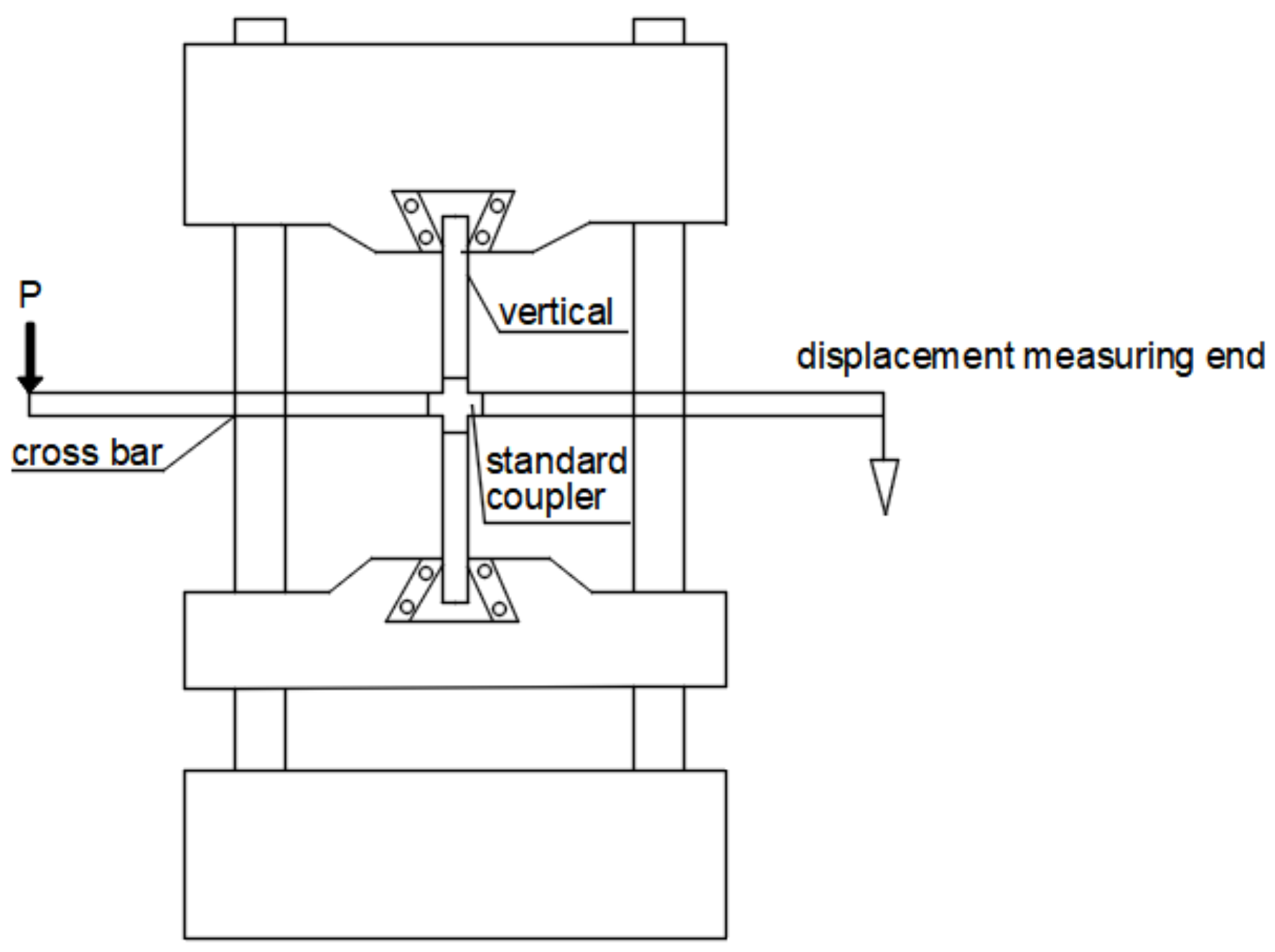
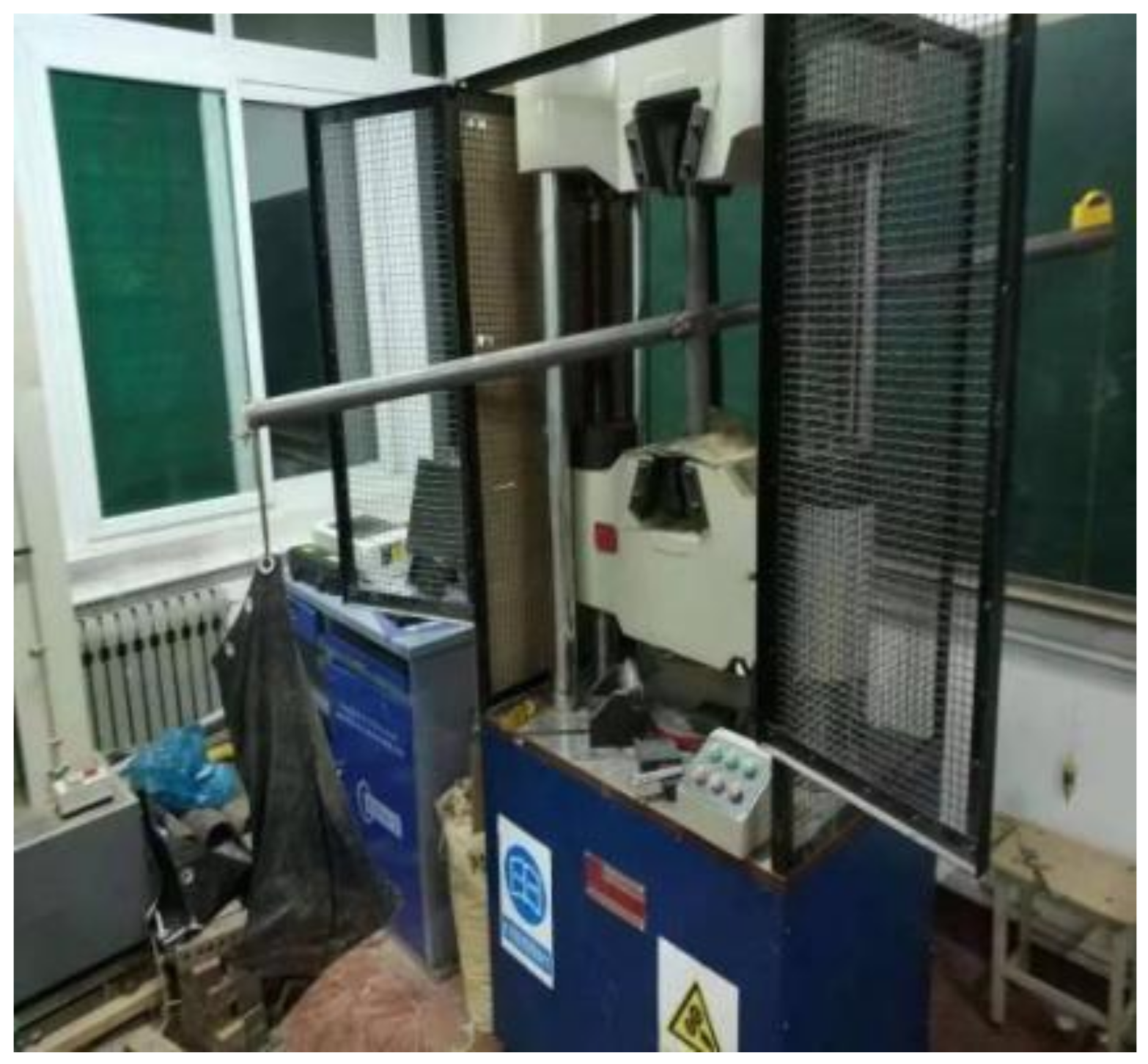
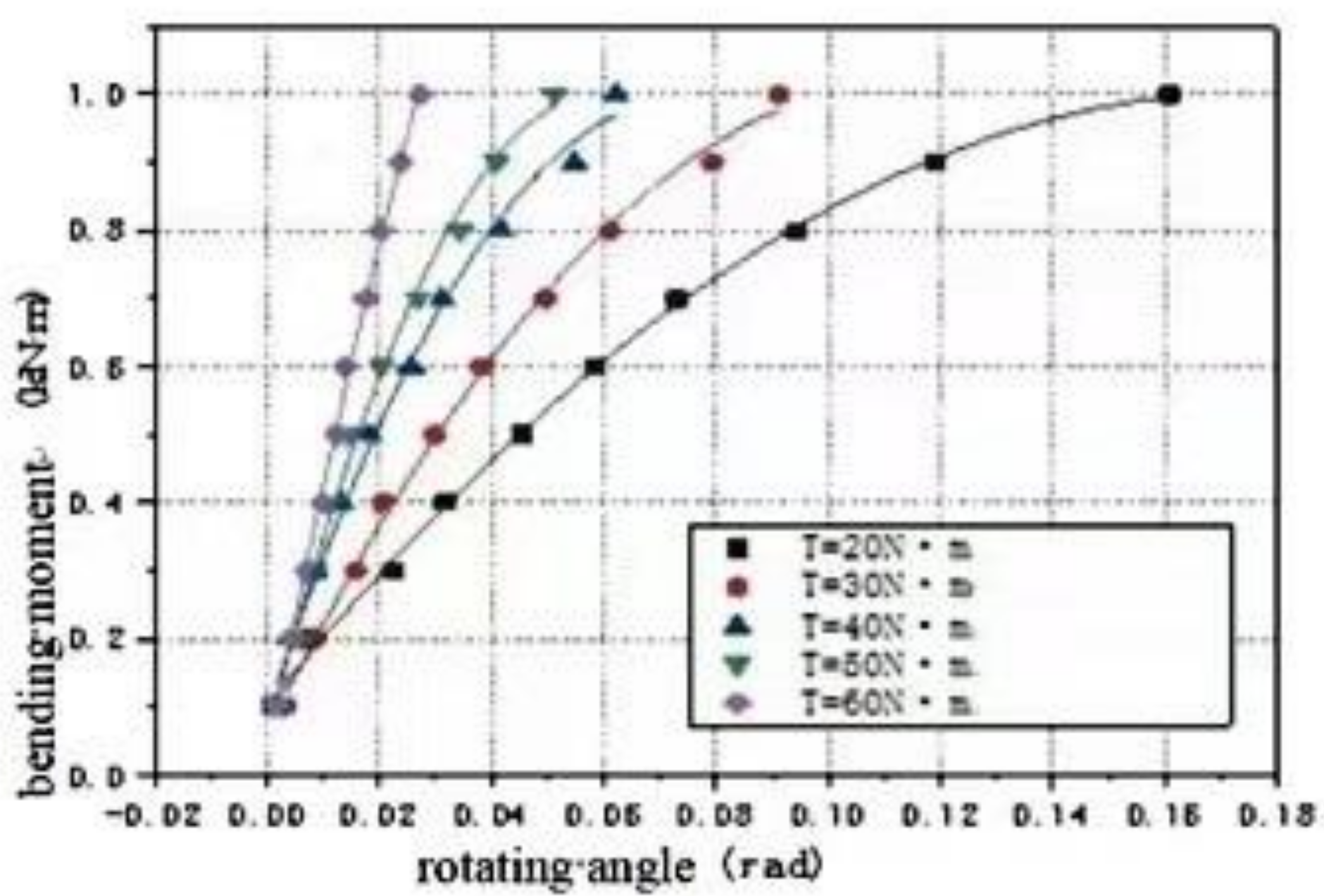
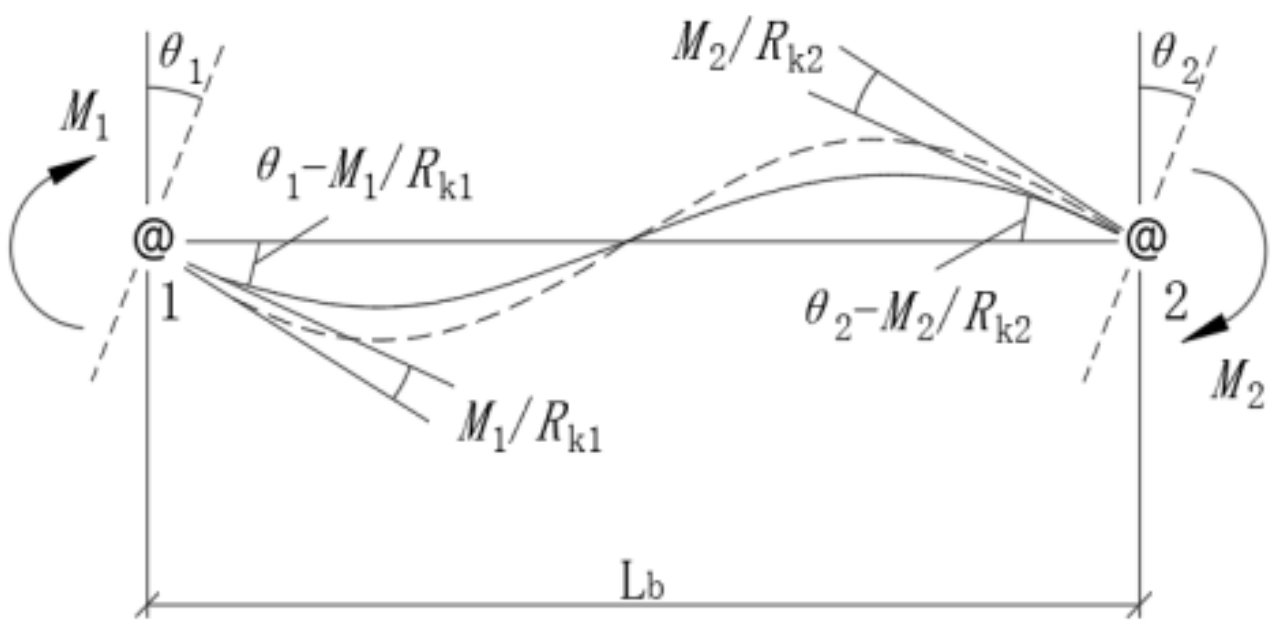
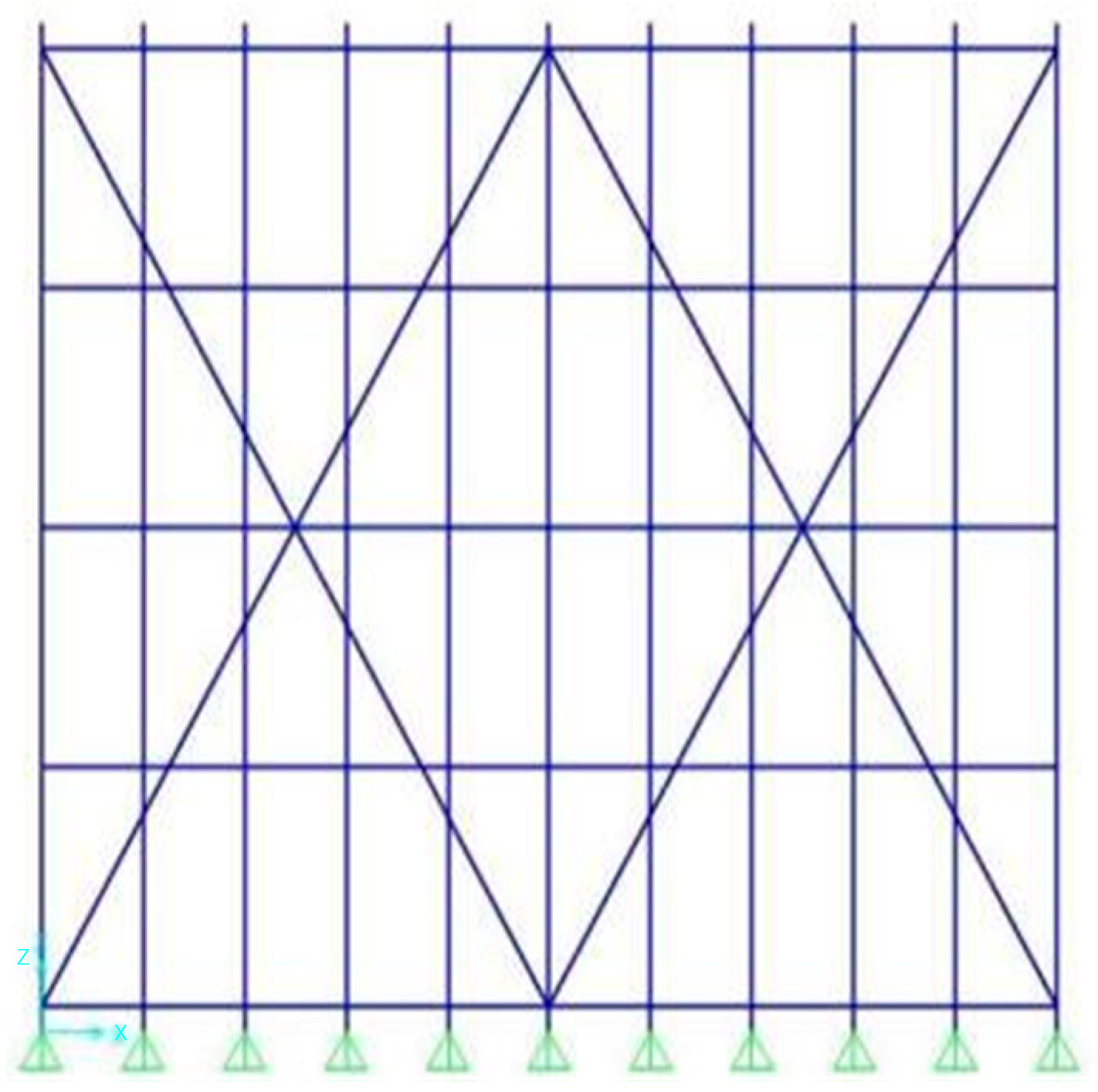
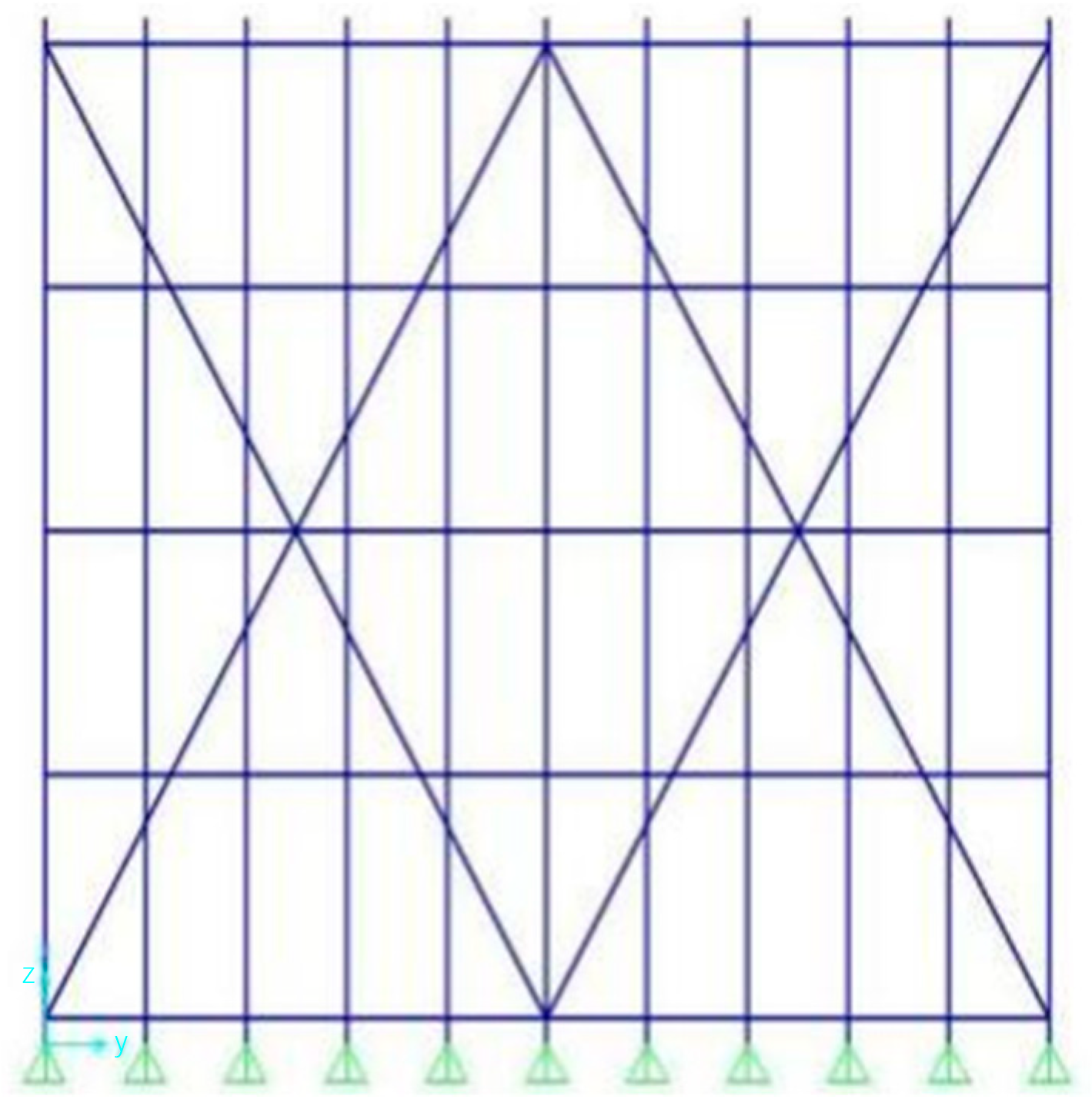

| Instrument Name | Parameter |
|---|---|
| Microcomputer controlled electrohydraulic servo Universal testing machine | regulating range: 800 mm–1300 mm |
| Torque wrench | moment range: 0–100 N· |
| Digital vernier caliper | Precision: 0.01 mm |
| Standard weights | 5 kg per mass |
| Test Number | Bolt Torsion Moment (N·m) | Rotating Angle Formula |
|---|---|---|
| KJ1-1 | 20 | |
| KJ1-2 | 30 | |
| KJ1-3 | 40 | |
| KJ1-4 | 50 | |
| KJ1-5 | 60 |
| Test Number | Moment of Twisting (N·m) | Fitting Formula | The Initial Stiffness Value of the Joint (kN·m/Rad) |
|---|---|---|---|
| KJ1-1 | 20 | + 10.14 + 0.10 | 10.14 |
| KJ1-2 | 30 | + 16.61 + 0.06 | 16.61 |
| KJ1-3 | 40 | + 24.35 + 0.09 | 24.35 |
| KJ1-4 | 50 | + 31.67 + 0.06 | 31.67 |
| KJ1-5 | 60 | + 42.37 + 0.02 | 42.37 |
| Moment of Twisting (N·m) | Joint Initial Rigidity (kN·m/rad) | Extension (m) | Lag Spacing (m) | Coefficient for Effective Length | Buckling Strength (kN) |
|---|---|---|---|---|---|
| 20 | 10.87 | 1.5 | 1.2 × 1.2 | 3.01 | 12.70 |
| 30 | 19.25 | 1.5 | 1.2 × 1.2 | 2.42 | 19.68 |
| 40 | 26.03 | 1.5 | 1.2 × 1.2 | 2.18 | 24.18 |
| 50 | 33.18 | 1.5 | 1.2 × 1.2 | 2.02 | 28.12 |
| 60 | 42.40 | 1.5 | 1.2 × 1.2 | 1.89 | 32.31 |
| Pace | Pole Pitch (m) | ||
|---|---|---|---|
| 1.2 × 1.2 | 1.0 × 1.0 | 0.9 × 0.9 | |
| 1.5 | 2.96 | 2.95 | 2.94 |
| 1.2 | 3.27 | 3.25 | 3.24 |
| Pace | Pole Pitch (m) | ||
|---|---|---|---|
| 1.2 × 1.2 | 1.0 × 1.0 | 0.9 × 0.9 | |
| 1.5 | 13.08 | 13.23 | 13.31 |
| 1.2 | 16.77 | 16.97 | 17.07 |
| Work Conditions | Pace (m) | Pole Pitch (m) | Height (m) | Stable Bearing Capacity (m) |
|---|---|---|---|---|
| 1 | 1.5 | 1.2 × 1.2 | <8 | 14.52 |
| 2 | 1.5 | 1.0 × 1.0 | <8 | 15.97 |
| 3 | 1.5 | 0.9 × 0.9 | <8 | 16.60 |
| 4 | 1.2 | 1.2 × 1.2 | <8 | 15.97 |
| 5 | 1.2 | 1.0 × 1.0 | <8 | 17.22 |
| 6 | 1.2 | 0.9 × 0.9 | <8 | 18.67 |
| Elastic Modulus (E, N/mm2) | Poisson’s Ratio (μ) | Yield Strength (f, N/mm2) |
|---|---|---|
| 2.06 × 105 | 0.3 | 205 |
| Outer Diameter d (mm) | Wall Thickness t (mm) | Cross-Sectional Area A (cm2) | Moment of Inertia I (cm4) | Turning Radius i (cm) |
|---|---|---|---|---|
| 48.3 | 3.6 | 5.06 | 12.71 | 1.59 |
| Work Conditions | Pace (m) | Pole Pitch (m) | Number of Vertical and Horizontal Spans | Height (m) |
|---|---|---|---|---|
| 1 | 1.5 | 1.2 × 1.2 | 10 | 7.9 |
| 2 | 1.5 | 1.0 × 1.0 | 10 | 7.9 |
| 3 | 1.5 | 0.9 × 0.9 | 10 | 7.9 |
| 4 | 1.2 | 1.2 × 1.2 | 10 | 7.6 |
| 5 | 1.2 | 1.0 × 1.0 | 10 | 7.6 |
| 6 | 1.2 | 0.9 × 0.9 | 10 | 7.6 |
| Work Conditions | Pace (m) | Pole Pitch (m) | Stable Bearing Capacity Theoretical (kN) | Stable Bearing Capacity Code Limit Value (kN) | Stable Load Carrying Capacity Finite Element Results (kN) |
|---|---|---|---|---|---|
| 1 | 1.5 | 1.2 × 1.2 | 13.08 | 14.52 | 17.92 |
| 2 | 1.5 | 1.0 × 1.0 | 13.23 | 15.97 | 18.93 |
| 3 | 1.5 | 0.9 × 0.9 | 13.31 | 16.60 | 19.48 |
| 4 | 1.2 | 1.2 × 1.2 | 16.77 | 15.97 | 20.51 |
| 5 | 1.2 | 1.0 × 1.0 | 16.97 | 17.22 | 21.86 |
| 6 | 1.2 | 0.9 × 0.9 | 17.07 | 18.67 | 22.58 |
Disclaimer/Publisher’s Note: The statements, opinions and data contained in all publications are solely those of the individual author(s) and contributor(s) and not of MDPI and/or the editor(s). MDPI and/or the editor(s) disclaim responsibility for any injury to people or property resulting from any ideas, methods, instructions or products referred to in the content. |
© 2023 by the authors. Licensee MDPI, Basel, Switzerland. This article is an open access article distributed under the terms and conditions of the Creative Commons Attribution (CC BY) license (https://creativecommons.org/licenses/by/4.0/).
Share and Cite
Ji, M.; Zeng, F.; Dong, Y.; Fan, Y. Calculation Method of Stable Bearing Capacity of Fastener-Type Steel Pipe Formwork Support Upright Rod. Appl. Sci. 2023, 13, 4838. https://doi.org/10.3390/app13084838
Ji M, Zeng F, Dong Y, Fan Y. Calculation Method of Stable Bearing Capacity of Fastener-Type Steel Pipe Formwork Support Upright Rod. Applied Sciences. 2023; 13(8):4838. https://doi.org/10.3390/app13084838
Chicago/Turabian StyleJi, Meng, Fankui Zeng, Yiping Dong, and Yuchuan Fan. 2023. "Calculation Method of Stable Bearing Capacity of Fastener-Type Steel Pipe Formwork Support Upright Rod" Applied Sciences 13, no. 8: 4838. https://doi.org/10.3390/app13084838
APA StyleJi, M., Zeng, F., Dong, Y., & Fan, Y. (2023). Calculation Method of Stable Bearing Capacity of Fastener-Type Steel Pipe Formwork Support Upright Rod. Applied Sciences, 13(8), 4838. https://doi.org/10.3390/app13084838





